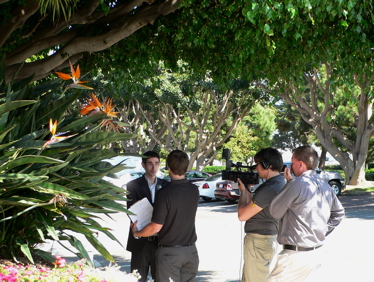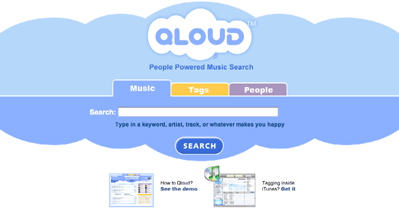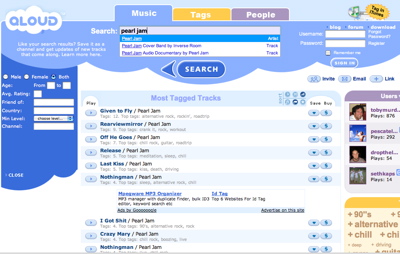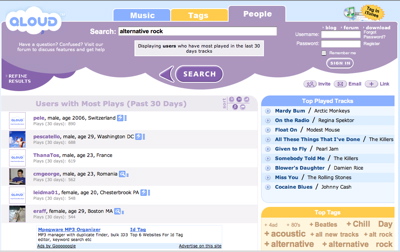Another DEMO event has come and gone, and it was a great one. Kudos again to Chris Shipley and team. These conferences go by so fast, but I try to capture as much as of the energy and optimism as I can from all the tremendous innovations that get launched here. It’s certainly a challenge to cover so many interesting, breakthrough technologies, but always a great conference experience. Entrepreneurship at its finest!
Didn’t get a chance to shoot a whole lot of photos this time — too darn busy meeting people, attending all the sessions, and (of course) writing posts! But I did get 50 pix or so up on Flickr. And I’ve included a selection of them here in this post.

As a recap, I thought it’d be fun to give you some facts about this conference. This year is the 17th straight for DEMO events (and two conferences per year have been held for many years now). The brand had its beginnings in 1991, founded by tech journalist Stewart Alsop, and was later acquired by IDG. It’s now run by the crack team from Network World Conferences. [By the way, speaking of Stewart Alsop, who became a VC several years ago — I was bummed that I had to miss hearing him deliver a keynote at an angel investor conference back here in Minnesota last week, because of all my travels. But I hear that event went very well, too.]
There were 69 companies pitching at DEMOfall this year, two of them public firms, and all the rest private — mostly small startups (and, in most cases, just coming out of stealth mode). Those 67 companies have amassed — get this — more than $450 million in funding to date! That’s an eye-popping average of $6.7 million each. (Of course, that figure is skewed somewhat by one DEMO presenting company, Jasper Wireless, which has already raised a cool $49 million! Its investors include my friends at Crescendo Ventures and BridgeScale.) As I mentioned in a previous post, 13 of the 69 companies were from countries other than the U.S. — quite a global contingent this year!  It was great to see and hear these entrepreneurs from other countries, and I got to meet several of them. [My favorite company name of that bunch: Red Square Ventures, from…guess where?] My post with links to all the presenting companies is here, and it lists where each of them is based. There were also 12 states represented — CA, as you may have guessed, had the most companies (32), with MA a distant second (6), then TX (5), and NY (4). Sadly, none yet from my adopted home state of MN — but I’m working on that. [Chris, trust me — we have several here waiting in the wings!] I was, however, instrumental in getting a firm from WI to DEMOfall this year, so I’m happy about that.
It was great to see and hear these entrepreneurs from other countries, and I got to meet several of them. [My favorite company name of that bunch: Red Square Ventures, from…guess where?] My post with links to all the presenting companies is here, and it lists where each of them is based. There were also 12 states represented — CA, as you may have guessed, had the most companies (32), with MA a distant second (6), then TX (5), and NY (4). Sadly, none yet from my adopted home state of MN — but I’m working on that. [Chris, trust me — we have several here waiting in the wings!] I was, however, instrumental in getting a firm from WI to DEMOfall this year, so I’m happy about that.
Attendance at the event was more than 700, which DEMO sums up as "corporate development executives, investors, influential journalists, and the most imaginative entrepreneurs in the world." I love that last bit. The press list numbered 76, including such venerable names as the Wall Street Journal, BusinessWeek, the Financial Times, The Economist, The Deal, CBS, the AP, Reuters, USA Today, the Washington Post, the LA Times, the Merc News, Wired, CNet, ZDNet, eWeek, Computerworld, NetworkWorld, InfoWorld….but that’s not all!  Several standout blogs were reporting on site as well, including Read/Write Web, GigaOM, Mashable, TechDirt, the new Blognation (Oliver Starr and Marc Orchant) — and (ahem) your buddy at Tech-Surf-Blog, of course… 🙂
Several standout blogs were reporting on site as well, including Read/Write Web, GigaOM, Mashable, TechDirt, the new Blognation (Oliver Starr and Marc Orchant) — and (ahem) your buddy at Tech-Surf-Blog, of course… 🙂
DEMO has quite a track record as a launchpad for some pretty amazing firms. Here are just some of them: Skype, WebEx, E*Trade, Six Apart, Salesforce.com, IronPort Systems, Moobella, Kaboodle, U.S. Robotics, and new ventures from such large firms as IBM, Sony, Motorola, Microsoft, and Adobe. It’s also launched such memorable products as TiVo, Half.com, Java 1.0, the Palm Pilot, and Ugobe’s Pleo toy.
This year’s DEMOfall had a good mix of consumer-facing, corporate computing, and enabling technologies. So,the event reflects activity across the entire technology industry. Here’s how this crop of presenters was categorized:
• Consumer technologies … 36 (5 devices, and fully 31 software and services offerings)
• Enabling technologies … 16
• Small business software and services … 10
• Enterprise software and services … 5
• IT management and infrastructure … 2

An interesting bunch of the small business tool companies got together the first night for beers, I was told, and decided their offerings were the solutions for "everyman," or all the "average Joes" out there. In the course of all this revelry, they coined a new term: "Web2.joe" — which is pretty funny. [Well, okay, maybe you had to be there.] They decided all their tools shared the main criteria needed by today’s small business people: affordable, easy to use, and customizable. These partying companies, a few of which I had a chance to later blog about, were BatchBlue, FastCall411, Advanta (ideablob), InstaCall, Vello, PlanHQ, and Tungle. I definitely think they’re all addressing a big need, and I’m sure we’re bound to be seeing more such small business tools, especially hosted apps, at future DEMO events. It’s such a huge market opportunity.

And that, friends, is what DEMO is all about: unlimited opportunity.
See you down the road at the next conference!



 It didn’t take the 800-pound gorilla long to figure out that advertisers were coveting all the space that content publishers have been devoting to widgets. Many of these advertisers would naturally like to push their wares inside little embedded, interactive pieces of web real estate, too. It’s not just about getting a click-through; these things offer great branding possibilities as well.
It didn’t take the 800-pound gorilla long to figure out that advertisers were coveting all the space that content publishers have been devoting to widgets. Many of these advertisers would naturally like to push their wares inside little embedded, interactive pieces of web real estate, too. It’s not just about getting a click-through; these things offer great branding possibilities as well. Mike grew up in Edina, MN, just about a mile from me, though we hadn’t met till he looked me up on his latest trip home. A veteran of online music, having worked at AOL and Ruckus after college at Dartmouth, he joined with former coworker Toby Mordock to found Qloud, and the pair received funding several months ago. [It’s from a notable source who must remain unnamed, or they’d have to kill me :-)…]
Mike grew up in Edina, MN, just about a mile from me, though we hadn’t met till he looked me up on his latest trip home. A veteran of online music, having worked at AOL and Ruckus after college at Dartmouth, he joined with former coworker Toby Mordock to found Qloud, and the pair received funding several months ago. [It’s from a notable source who must remain unnamed, or they’d have to kill me :-)…]




Recent Comments